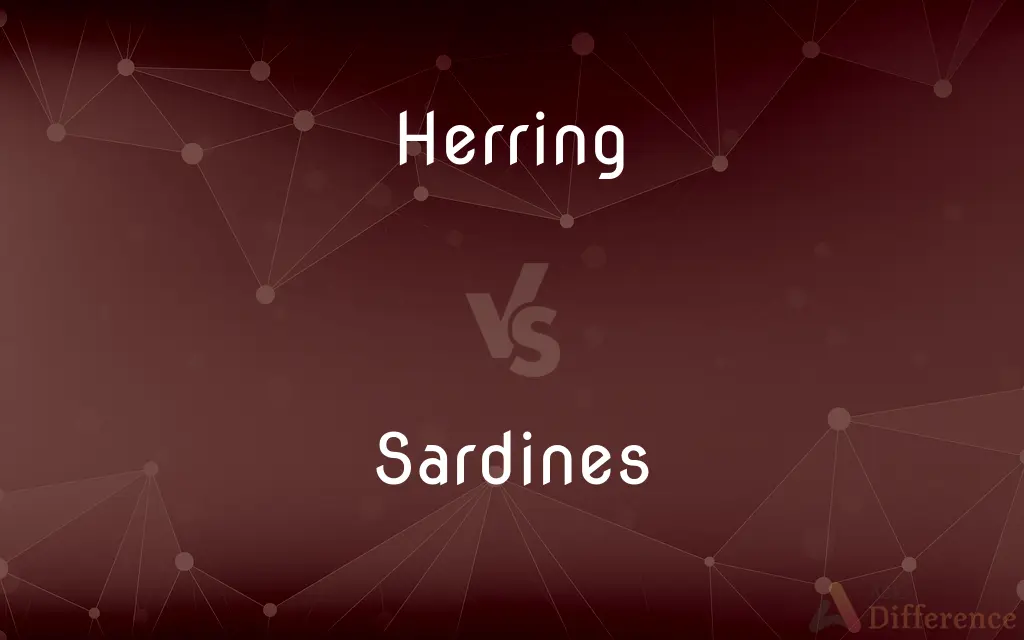Herring vs. Sardines — What's the Difference?
Edited by Tayyaba Rehman — By Fiza Rafique — Updated on May 8, 2024
Herring and sardines are both small, oily fish widely consumed globally, but herring is typically larger and found in colder waters, whereas sardines are smaller, more delicate, and often found in warmer seas.

Difference Between Herring and Sardines
Table of Contents
ADVERTISEMENT
Key Differences
Herring are a group of fish species under the family Clupeidae, known for their larger size and significant role in the food chain in colder ocean waters. Sardines, smaller members of the herring family, are also categorized under Clupeidae but are specifically classified into several species including Sardina and Sardinops.
Herring can be found in both the Atlantic and Pacific Oceans, thriving in temperate to cold waters, and are known for their size, which can range from about 20 to 40 cm in length. Sardines are generally found in warmer waters, including the Atlantic, Pacific, and Mediterranean Seas, and are smaller, typically not exceeding 25 cm.
In terms of culinary use, herring is often preserved through smoking, pickling, or salting, which gives it a strong, distinct flavor. Sardines are commonly canned in oil or sauces, providing a softer texture and milder taste compared to herring.
Nutritional profiles of both fish are similar, offering high levels of omega-3 fatty acids, protein, and vitamins D and B12. However, herring tends to have slightly higher fat content, which contributes to its richer flavor.
Both herring and sardines play crucial ecological roles, serving as prey for a wide range of marine predators, such as larger fish, marine mammals, and seabirds. They are also significant to global fisheries due to their demand in the food industry.
ADVERTISEMENT
Comparison Chart
Size
Typically 20-40 cm in length.
Generally smaller, up to 25 cm in length.
Habitat
Colder, temperate to cold waters of Atlantic and Pacific Oceans.
Warmer waters, including Atlantic, Pacific, and Mediterranean Seas.
Culinary Uses
Often smoked, pickled, or salted.
Commonly canned in oil or sauces.
Nutrition
High in omega-3 fatty acids, protein, vitamin D, and B12. Slightly higher fat content.
Similar nutritional benefits but generally milder in flavor.
Ecological Role
Serve as important prey for larger marine predators.
Crucial part of the marine food chain.
Compare with Definitions
Herring
This fish plays a significant role in its ecosystem by providing food for predators like whales and seabirds.
Herring schools are a vital feeding ground for migrating whales.
Sardines
They are an integral part of the ocean food chain, serving as essential prey for larger fish.
Sardines are a key food source for predatory fish in the Atlantic.
Herring
A species of fish belonging to the family Clupeidae, known for its larger size and preference for cold waters.
The Atlantic herring is crucial for the fishing industry in northern Europe.
Sardines
Small oily fish within the herring family, typically found in warmer waters and known for being canned.
Sardines from the Mediterranean are often canned with olive oil and herbs.
Herring
Herring are commonly used in traditional dishes where they are smoked or pickled.
Pickled herring is a popular snack in Scandinavia.
Sardines
Sardines are important for human consumption due to their nutritional content, including omega-3 fatty acids.
Sardines are a budget-friendly source of omega-3 for many diets.
Herring
Herring are forage fish, mostly belonging to the family Clupeidae. Herring often move in large schools around fishing banks and near the coast, found particularly in shallow, temperate waters of the North Pacific and North Atlantic Oceans, including the Baltic Sea, as well as off the west coast of South America.
Sardines
Any of various edible fishes of the family Clupeidae that are frequently canned, especially small herrings of western Atlantic waters and Sardina pilchardus of European waters.
Herring
Any of various silvery fishes of the family Clupeidae, especially the commercially important Clupea harengus of the northern Atlantic Ocean and C. pallasii of the northern Pacific Ocean.
Sardines
Any of various other small, silvery, edible freshwater or marine fishes.
Herring
A type of small, oily fish of the genus Clupea, often used as food.
Sardines
To pack tightly; cram
"The bars are sardined with hungry hopefuls" (Gael Greene).
Herring
Fish in the family Clupeidae.
Sardines
Plural of sardine
Herring
Fish similar to those in genus Clupea, many of those in the order Clupeiformes.
Sardines
(uncountable) A children's game in which the players hide together, lying side by side.
Herring
One of various species of fishes of the genus Clupea, and allied genera, esp. the common round or English herring (Clupea harengus) of the North Atlantic. Herrings move in vast schools, coming in spring to the shores of Europe and America, where they are salted and smoked in great quantities.
Herring
Valuable flesh of fatty fish from shallow waters of northern Atlantic or Pacific; usually salted or pickled
Herring
Commercially important food fish of northern waters of both Atlantic and Pacific
Common Curiosities
How are herring and sardines typically eaten?
Herring is often eaten pickled or smoked, while sardines are usually canned.
Why are herring and sardines important to fisheries?
They are heavily fished due to high demand in global food markets and their role in ecosystems.
What makes herring different from sardines?
Herring are generally larger and found in colder waters compared to the smaller, warmer-water sardines.
Which is healthier, herring or sardines?
Both are healthy, offering high levels of essential nutrients, though herring has slightly more fat.
Can you substitute sardines for herring in recipes?
Yes, but expect a milder flavor and softer texture with sardines compared to the stronger, richer herring.
What are the environmental impacts of fishing for herring and sardines?
Overfishing can lead to declines in population levels, affecting marine ecosystems.
Where are herring and sardines most commonly found?
Herring are found in the colder Atlantic and Pacific Oceans, while sardines are found in warmer waters like the Atlantic, Pacific, and Mediterranean.
How do herring and sardines contribute to the marine food chain?
They serve as crucial prey for a variety of larger predators, supporting marine biodiversity.
How can consumers choose sustainable herring and sardine products?
Look for certifications like MSC (Marine Stewardship Council) on labels to ensure sustainable fishing practices.
What is the peak season for catching herring and sardines?
This varies by region but typically aligns with their spawning cycles when they are most abundant.
What are some popular dishes made with herring and sardines?
Dishes like kippers (smoked herring) and sardines on toast are popular in different parts of the world.
How should herring and sardines be stored if purchased fresh?
Keep refrigerated and consume within a few days for best quality.
What are the main fishing methods for herring and sardines?
They are typically caught using nets due to their schooling nature.
Are there any cultural significances associated with herring and sardines?
Yes, both have been important traditional foods in many cultures, particularly in Europe and Asia.
Share Your Discovery

Previous Comparison
Peristalsis vs. Segmentation
Next Comparison
Ductility vs. MalleabilityAuthor Spotlight
Written by
Fiza RafiqueFiza Rafique is a skilled content writer at AskDifference.com, where she meticulously refines and enhances written pieces. Drawing from her vast editorial expertise, Fiza ensures clarity, accuracy, and precision in every article. Passionate about language, she continually seeks to elevate the quality of content for readers worldwide.
Edited by
Tayyaba RehmanTayyaba Rehman is a distinguished writer, currently serving as a primary contributor to askdifference.com. As a researcher in semantics and etymology, Tayyaba's passion for the complexity of languages and their distinctions has found a perfect home on the platform. Tayyaba delves into the intricacies of language, distinguishing between commonly confused words and phrases, thereby providing clarity for readers worldwide.













































